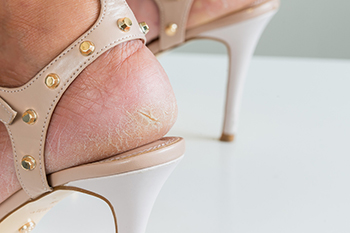Same Day or Next Day Appointments Available Laredo (956) 726-9797 Se Habla Español
Same Day or Next Day Appointments Available Laredo (956) 726-9797 Se Habla Español

When we are born, our feet are soft, supple, and beautiful. As we age, the softness decreases and the skin on our feet can become thick, hard, and our heels can crack. It is when the thick, dry skin on our feet and heels become cracked that problems can arise. A heel crack is also known as a heel fissure. The skin cannot bear the pressure of our body if it is too dry, thick, and flaky, which creates cracks. It is an unpleasant and unsightly condition and sometimes severe cracks can bleed and become infected. Initially, the skin on the heels will look yellow or dark brown. Then thread-like cracks will appear. Skin on the feet and heels can become cracked from internal and external causes. Internal causes include lack of moisture, dehydration, poor nutrition, aging, obesity, genetics, some skin diseases (such as psoriasis, corns, eczema), and other health disorders, like diabetes. External factors causing cracked heels include prolonged standing, weight put on the feet (from lifting something heavy), poorly fitting shoes or shoes with open backs or hard soles, poor foot hygiene, excess contact with water (even bathing too frequently), exposure to winter weather, using harsh, drying soaps, or scrubbing too much. If you have cracked feet or heels and they are creating discomfort that is not mitigated by tending to the factors that created them, consult with a podiatrist who can treat the condition and teach you ways to prevent this from happening again.
Cracked heels are unsightly and can cause further damage to your shoes and feet. If you have any concerns, contact Jed Wells, DPM from Jed Wells, DPM Foot Specialist. Our doctor can provide the care you need to keep you pain-free and on your feet.
Cracked Heels
Cracked heels appear unappealing and can make it harder for you walk around in sandals. Aside from looking unpleasant, cracked heels can also tear stockings, socks, and wear out your shoes. There are several methods to help restore a cracked heel and prevent further damage.
How Do You Get Them?
Dry skin is the number one culprit in creating cracked heels. Many athletes, walkers, joggers, and even swimmers suffer from cracked heels. Age and skin oil production play a role to getting cracked heels as well.
Promote Healing
Over the counter medicines can help, especially for those that need instant relief or who suffer from chronic dry feet.
Wear Socks – Wearing socks with medicated creams helps lock in moisture.
Moisturizers – Applying both day and night will help alleviate dryness which causes cracking.
Pumice Stones – These exfoliate and remove dead skin, which allows for smoother moisturizer application and better absorption into the skin.
Change in Diet
Eating healthy with a well-balanced diet will give the skin a fresh and radiant look. Your body responds to the kinds of food you ingest. Omega-3 fatty acids and zinc supplements can also revitalize skin tissue.
Most importantly, seek professional help if unsure how to proceed in treating cracked heels. A podiatrist will help you with any questions or information needed.
If you have any questions, please feel free to contact our offices located in Corpus Christi, and Laredo, TX . We offer the newest diagnostic and treatment technologies for all your foot care needs.







